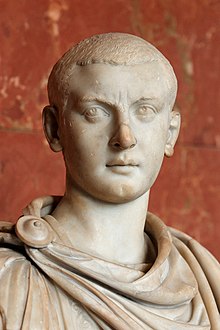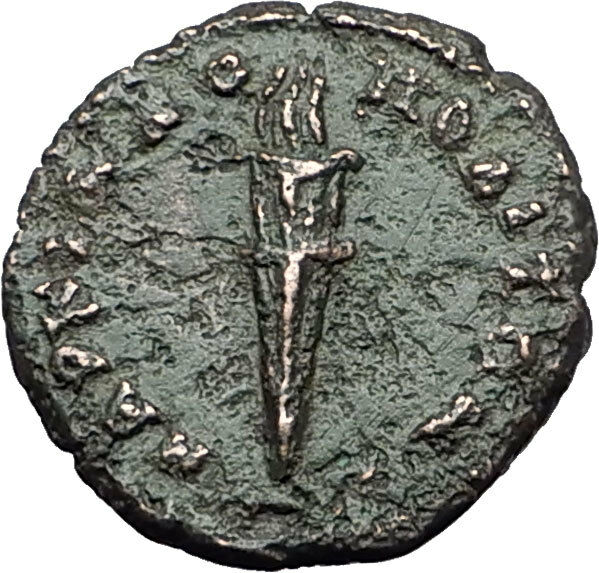|
Gordian III – Roman Emperor: 238-244 A.D.
Bronze 26mm (11.64 grams) of Nicopolis ad Istrum in Moesia Inferior under Sabinius Modestus, consular legate
AVT K M ANTΩ ΓΟΡΔΙΑΝΟC AVΓ, Laureate, draped and cuirassed bust right.
VΠ CAB MOΔЄCTOV NIKOΠOΛЄITΩN ΠPOC ICTPON, Asclepius (god of medicine) standing facing with his head left, leaning on serpent-entwined (symbol of medicine) staff.
You are bidding on the exact item pictured, provided with a Certificate of Authenticity and Lifetime Guarantee of Authenticity.
.JPG/200px-Statue_of_Asklepios_NAMA_263_(DerHexer).JPG)  Asclepius is the god of medicine and healing in ancient Greek religion. Asclepius represents the healing aspect of the medical arts; his daughters are Hygieia (“Health”), Iaso (“Medicine”), Aceso (“Healing”), and Panacea (“Universal Remedy”). The rod of Asclepius, a snake-entwined staff, remains a symbol of medicine today, although sometimes the caduceus, or staff with two snakes, is mistakenly used instead. He was associated with the Roman/Etruscan god Vediovis. He was one of Apollo’s servants. Asclepius is the god of medicine and healing in ancient Greek religion. Asclepius represents the healing aspect of the medical arts; his daughters are Hygieia (“Health”), Iaso (“Medicine”), Aceso (“Healing”), and Panacea (“Universal Remedy”). The rod of Asclepius, a snake-entwined staff, remains a symbol of medicine today, although sometimes the caduceus, or staff with two snakes, is mistakenly used instead. He was associated with the Roman/Etruscan god Vediovis. He was one of Apollo’s servants.
The rod of Asclepius, also known as the asklepian, is an ancient symbol associated with astrology, the Greek god Asclepius and with medicine and healing. It consists of a serpent entwined around a staff. The name of the symbol derives from its early and widespread association with Asclepius, the son of Apollo, who was a practitioner of medicine in ancient Greek mythology. His attributes, the snake and the staff, sometimes depicted separately in antiquity, are combined in this symbol. The Rod of Asclepius also represents the constellation Ophiuchus (or Ophiuchus Serpentarius), the thirteenth sign of the sidereal zodiac. Hippocrates himself was a worshipper of Asclepius.
Nicopolis ad Istrum was a Roman and Early Byzantine town founded by Emperor Trajan around 101-106, at the junction of the Iatrus (Yantra) and the Rositsa rivers, in memory of his victory over the Dacians. Its ruins are located at the village of Nikyup, 20 km north of Veliko Tarnovo in northern Bulgaria. The town reached its apogee during the reigns of Trajan, Hadrian, the Antonines and the Severan dynasty.
The classical town was planned according to the orthogonal system. The network of streets, the forum surrounded by an Ionic colonnade and many buildings, a two-nave room later turned into a basilica and other public buildings have been uncovered. The rich architectures and sculptures show a similarity with those of the ancient towns in Asia Minor. Nicopolis ad Istrum had issued coins, bearing images of its own public buildings.
In 447 AD, the town was destroyed by Attila’s Huns. Perhaps it was already abandoned before the early 400s. In the 6th century, it was rebuilt as a powerful fortress enclosing little more than military buildings and churches, following a very common trend for the cities of that century in the Danube area.The largest area of the extensive ruins (21.55 hectares) of the classical Nicopolis was not reoccupied since the fort covered only one fourth of it (5.75 hectares), in the southeastern corner. The town became an episcopal centre during the early Byzantine period. It was finally destroyed by the Avar invasions at the end of the 6th century. A Bulgarian medieval settlement arose upon its ruins later (10th-14th century).
Nicopolis ad Istrum can be said to have been the birthplace of Germanic literary tradition. In the 4th century, the Gothic bishop, missionary and translator Ulfilas (Wulfila) obtained permission from Emperor Constantius II to immigrate with his flock of converts to Moesia and settle near Nicopolis ad Istrum in 347-8. There, he invented the Gothic alphabet and translated the Bible from Greek to Gothic.
Gordian III – Roman Emperor: 238-244 A.D.
Caesar: 238 A.D. (under Balbinus and Pupienus)
Augustus: 238-244 A.D.
| Grandson of Gordian I | Nephew of Gordian II | Adopted Successor of Balbinus and Pupienus | Husband of Tranquillina |

Gordian III (Latin: Marcus Antonius Gordianus Pius Augustus; 20 January 225 AD – 11 February 244 AD) was Roman Emperor from 238 AD to 244 AD. At the age of 13, he became the youngest sole legal Roman emperor throughout the existence of the united Roman Empire. Gordian was the son of Antonia Gordiana and an unnamed Roman Senator who died before 238. Antonia Gordiana was the daughter of Emperor Gordian I and younger sister of Emperor Gordian II. Very little is known of his early life before his acclamation. Gordian had assumed the name of his maternal grandfather in 238 AD.
In 235, following the murder of Emperor Alexander Severus in Moguntiacum (modern Mainz), the capital of the Roman province Germania Superior, Maximinus Thrax was acclaimed Emperor. In the following years, there was a growing opposition against Maximinus in the Roman senate and amongst the majority of the population of Rome. In 238 a rebellion broke out in the Africa Province, where Gordian’s grandfather and uncle, Gordian I and II, were proclaimed joint emperors. This revolt was suppressed within a month by Cappellianus, governor of Numidia and a loyal supporter of Maximinus Thrax. The elder Gordians died, but public opinion cherished their memory as peace-loving and literate men, victims of Maximinus’ oppression.
Meanwhile, Maximinus was on the verge of marching on Rome and the Senate elected Pupienus and Balbinus as joint emperors. These senators were not popular men and the population of Rome was still shocked by the elder Gordian’s fate, so the Senate decided to take the teenager Gordian, rename him Marcus Antonius Gordianus like his grandfather, and raise him to the rank of Caesar and imperial heir. Pupienus and Balbinus defeated Maximinus, mainly due to the defection of several legions, particularly the II Parthica, who assassinated Maximinus. However, their joint reign was doomed from the start with popular riots, military discontent and an enormous fire that consumed Rome in June 238. On July 29, Pupienus and Balbinus were killed by the Praetorian Guard and Gordian proclaimed sole emperor.
Rule
Due to Gordian’s age, the imperial government was surrendered to the aristocratic families, who controlled the affairs of Rome through the Senate. In 240, Sabinianus revolted in the African province, but the situation was quickly brought under control. In 241, Gordian was married to Furia Sabinia Tranquillina, daughter of the newly appointed praetorian prefect, Timesitheus. As chief of the Praetorian Guard and father in law of the Emperor, Timesitheus quickly became the de facto ruler of the Roman Empire.
In the 3rd century, the Roman frontiers weakened against the Germanic tribes across the Rhine and Danube, and the Sassanid Empire across the Euphrates increased its own attacks. When the Persians under Shapur I invaded Mesopotamia, the young emperor opened the doors of the Temple of Janus for the last time in Roman history, and sent a large army to the East. The Sassanids were driven back over the Euphrates and defeated in the Battle of Resaena (243). The campaign was a success and Gordian, who had joined the army, was planning an invasion of the enemy’s territory, when his father-in-law died in unclear circumstances. Without Timesitheus, the campaign, and the Emperor’s security, were at risk.
Gaius Julius Priscus and, later on, his own brother Marcus Julius Philippus, also known as Philip the Arab, stepped in at this moment as the new Praetorian Prefects and the campaign proceeded. Around February 244, the Persians fought back fiercely to halt the Roman advance to Ctesiphon. Persian sources claim that a battle occurred (Battle of Misiche) near modern Fallujah (Iraq) and resulted in a major Roman defeat and the death of Gordian III. Roman sources do not mention this battle and suggest that Gordian died far away from Misiche, at Zaitha (Qalat es Salihiyah) in northern Mesopotamia. Modern scholarship does not unanimously accept this course of the events. One view holds that Gordian died at Zaitha, murdered by his frustrated army, while the role of Philip is unknown. Other scholars, such as Kettenhofen, Hartman and Winter have concluded that Gordian died in battle against the Sassanids.
Philip transferred the body of the deceased emperor to Rome and arranged for his deification. Gordian’s youth and good nature, along with the deaths of his grandfather and uncle and his own tragic fate at the hands of the enemy, earned him the lasting esteem of the Romans. The soldiers held Gordian in high esteem, as he had possibly sacrificed his life to save them in 244.
|





.JPG/200px-Statue_of_Asklepios_NAMA_263_(DerHexer).JPG)
 Asclepius is the god of medicine and healing in ancient Greek religion. Asclepius represents the healing aspect of the medical arts; his daughters are Hygieia (“Health”), Iaso (“Medicine”), Aceso (“Healing”), and Panacea (“Universal Remedy”). The rod of Asclepius, a snake-entwined staff, remains a symbol of medicine today, although sometimes the caduceus, or staff with two snakes, is mistakenly used instead. He was associated with the Roman/Etruscan god Vediovis. He was one of Apollo’s servants.
Asclepius is the god of medicine and healing in ancient Greek religion. Asclepius represents the healing aspect of the medical arts; his daughters are Hygieia (“Health”), Iaso (“Medicine”), Aceso (“Healing”), and Panacea (“Universal Remedy”). The rod of Asclepius, a snake-entwined staff, remains a symbol of medicine today, although sometimes the caduceus, or staff with two snakes, is mistakenly used instead. He was associated with the Roman/Etruscan god Vediovis. He was one of Apollo’s servants.





